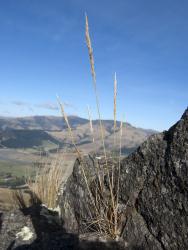- Taxon
- Gallery
Dark green to grey-green usually slender tufts, (12)–20–110 cm; branching extravaginal. Leaf-sheath firmly membranous, obviously ribbed, smooth, or rarely scabrid near ligule, brownish, sometimes purplish. Ligule 0.5–4.5 mm, truncate or tapered, ciliate, abaxially with very minute hairs. Leaf-blade (2)–4–15–(24) cm × 0.3–1.5 mm diam., inrolled, abaxially smooth, very rarely scabrid, adaxially scabrid, margins scabrid, tip acute, scabrid. Culm (7.5)–15–75 cm, varying in diameter, usually 0.3–0.5 mm diam. in plants with cleistogamous flowers and 0.8–2.5–(3) mm diam. in plants with chasmogamous flowers, erect or curved upwards from decumbent base, internodes glabrous. Panicle (1)–3.5–20–(28) cm × 1.5–17 mm, erect or ± nodding, shining, lanceolate, cylindric above, narrowly branched with spikelets densely crowded throughout, lower branches ± distant; rachis smooth, branches and pedicels sparsely scaberulous. Spikelets 3–7 mm, 1–(2)-flowered, light green to purplish green. Glumes 1-nerved, lanceolate, acute to acuminate, smooth, midnerve minutely scabrid in upper ⅔. Lemma 2.8–5.3 mm, ⊬ glumes, firmly membranous, minutely scabrid-papillose, narrow elliptic-lanceolate, involute, apex acute or occasionally finely bifid; awn 4.5–8.5 mm, from lower ⅓ of lemma and overtopping glumes. Palea ⊬ lemma, keels scabrid in upper ⅔, tip acute to subacute. Callus hairs few, to c. 1 mm, ⅕-⅓ length of lemma or shorter. Rachilla prolongation (0.5)–0.8–1.5–(2) mm, tipped by an almost equally long, slender tuft of fine hairs reaching to ⅔ length of lemma. Lodicules 0.5–1 mm, ovate-lanceolate, subacute. Anthers 0.2–0.7–(1.2) mm in cleistogamous flowers, (0.5)–0.8–1.4–(2) mm in chasmogamous flowers. Caryopsis 1.5–2.3 × 0.4–0.9 mm.
[From: Edgar and Connor (2000) Flora of New Zealand. Volume 5 (second printing).]




